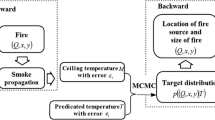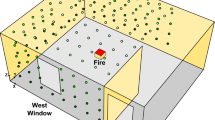Abstract
The dynamical evolution of a multiple fuel package fire leaves thermal signatures. For practical and theoretical reasons, it is important to determine conditions in which one can identify the path the system took by conducting a set of experiments that cover the space of all possible paths. An experimental fire compartment capable of producing repeatable and highly customizable fire-evolution scenarios is presented. Instrumented propane burners are configured in the compartment each with a simple critical heat flux ignition model. Heat flux sensors are located around the burner configuration to provide temporal incident heat flux measurements. Data from several hypotheses representing possible scenarios are compared to data generated using some true configuration using a Bayesian methodology. The Bayesian methodology is able to illicit the correct fire-evolution scenario from the set of hypotheses with a high degree of confidence. The information content provided by each sensor is analyzed to highlight the importance of sensor location in determining the fire-evolution. Posteriors for the hypotheses using two different error structures are also compared over the sensors to highlight the importance of choosing the correct error structure.







Similar content being viewed by others
References
NFPA (2014) NFPA 921-guide for fire and explosion investigations. National Fire Protection Association
Strengthening forensic science in the united states: A path forward. Technical report, National Research Council (2009)
Gorbett GE, Chapdelaine W (2014) Scientific method-use, application, and gap analysis for origin determination. In: International symposium on fire investigation science and technology
Cox A (2013) Origin matrix analysis: a systematic methodology for the assessment and interpretation of compartment fire damage. Fire Arson Investig 64(1):1–27
Gorbett GE, Meacham BJ, Wood CB, Dembsey NA (2015) Use of damage in fire investigation: a review of fire patterns analysis, research and future direction. Fire Sci Rev 4:1–35. https://doi.org/10.1186/s40038-015-0008-4
Gorbett GE, Wood CB (2017) Structure and evaluation of the process for origin determination in compartment fires. Fire Technol 53:301–327
Hopkins RL, Gorbett G, Kennedy P (1997) Fire pattern persistence and predictability on interior finish and construction materials during pre and post flashover compartment fires. Technical report
Madrzykowski D, Fleischmann C (2012) Fire pattern repeatability: a study in uncertainty. J Test Evaluat 40(1):1
Madrzykowski D, Weinschenk C (2019) Impact of fixed ventilation on fire damage patterns in full-scale structures. Technical report, UL Firefighter Safety Research Institute
Stauffer E (2019) Interpol review of fire investigation 2016–2019. Forensic Science International, pp 1–14
Nordgaard A, Rasmusson B (2017) The likelihood ratio as value of evidence—more than a question of numbers. Fire Technol 53:301–327
Wang J, Zabaras N (2004) A Bayesian inference approach to the inverse heat conduction problem. Int J Heat Mass Transf 47:3927–3941
Biedermann A, Taroni F, Delemont O, Semadeni C, Davison AC (2005) The evaluation of evidence in the forensic investigation of fire incidents (part i): an approach using Bayesian networks. Forensic Sci Int 147(1):49–57
Biedermann A, Taroni F, Delemont O, Semadeni C, Davison AC (2005) The evaluation of evidence in the forensic investigation of fire incidents. Part II. Practical examples of the use of Bayesian networks. Forensic Sci Int 147(1):59–69
Overholt KJ, Ezekoye OA (2012) Characterizing heat release rates using an inverse fire modeling technique. Fire Technol 48:893–909
Overholt KJ (2013) Forward and inverse modeling of fire physics towards fire scene reconstructions. Ph.D. thesis, The University of Texas at Austin, Austin, TX
Overholt KJ, Ezekoye OA (2014) Quantitative testing of fire scenario hypotheses: a bayesian inference approach. Fire Technol 51(2):335–367
Kurzawski AJ, Cabrera JM, Ezekoye OA (2019) Model considerations for fire scene reconstruction using a bayesian framework. Fire Technol 56:1–23. https://doi.org/10.1007/s10694-019-00886-w
Weinschenk C, Beal CM, Ezekoye OA (2011) Modeling fan-driven flows for firefighting tactics using simple analytical models and CFD. J Fire Protect Eng 21:85–114
Overholt K, Ezekoye OA (2014) Quantitative testing of fire scenario hypotheses, a bayesian inference approach. Fire Technol 51:335–367
Kurzawski AJ (2017) Inverse modeling and characterization of an experimental testbed to advance fire scene reconstruction. Ph.D. thesis, The University of Texas at Austin, Austin, Texas
Standard methods of fire tests for evaluating contribution of wall and ceiling interior finish to room fire growth. Standard, National Fire Protection Agency (2019)
American Society for Testing and Materials, West Conshohocken, Pennsylvania. ASTM E 3057-16 Standard Test Method for Measuring Heat Flux Using Directional Flame Thermometers with Advanced Data Analysis Techniques (2016)
Cabrera JM, Moser RD, Ezekoye OA (2020) A modified directional flame thermometer: development, calibration, and uncertainty quantification. J Verif Valid Uncertain Quant 5:1–10
Rasmussen CE, Williams CKI (2006) Gaussian processes for machine learning. MIT Press, Cambridge
Acknowledgements
This work is supported by U.S. National Science Foundation under Award No. 1707090.
Author information
Authors and Affiliations
Corresponding author
Additional information
Publisher's Note
Springer Nature remains neutral with regard to jurisdictional claims in published maps and institutional affiliations.
Rights and permissions
About this article
Cite this article
Cabrera, JM., Ezekoye, O.A. & Moser, R.D. Bayesian Inference of Fire Evolution Within a Compartment Using Heat Flux Measurements. Fire Technol 57, 2887–2903 (2021). https://doi.org/10.1007/s10694-020-01036-3
Received:
Accepted:
Published:
Issue Date:
DOI: https://doi.org/10.1007/s10694-020-01036-3




